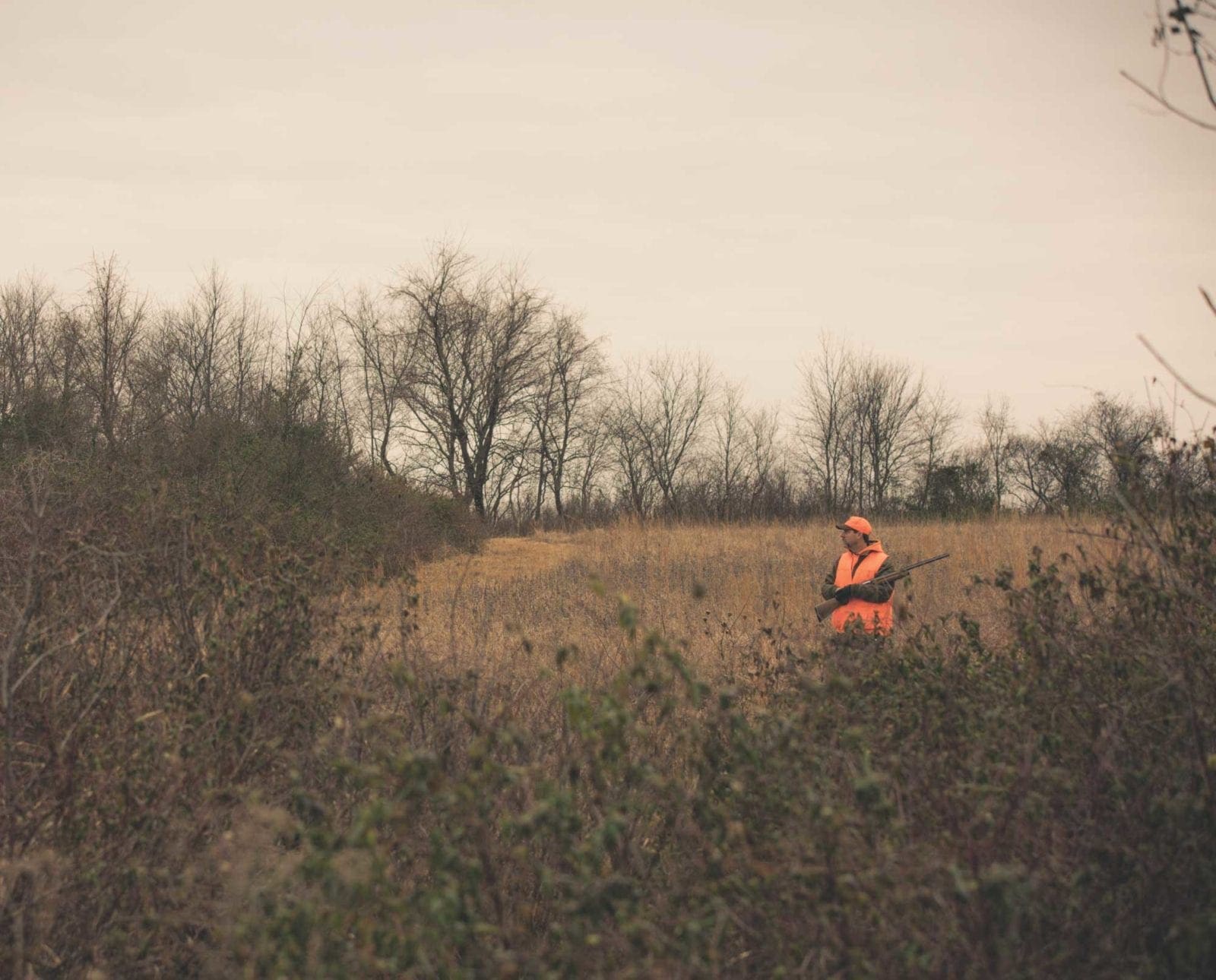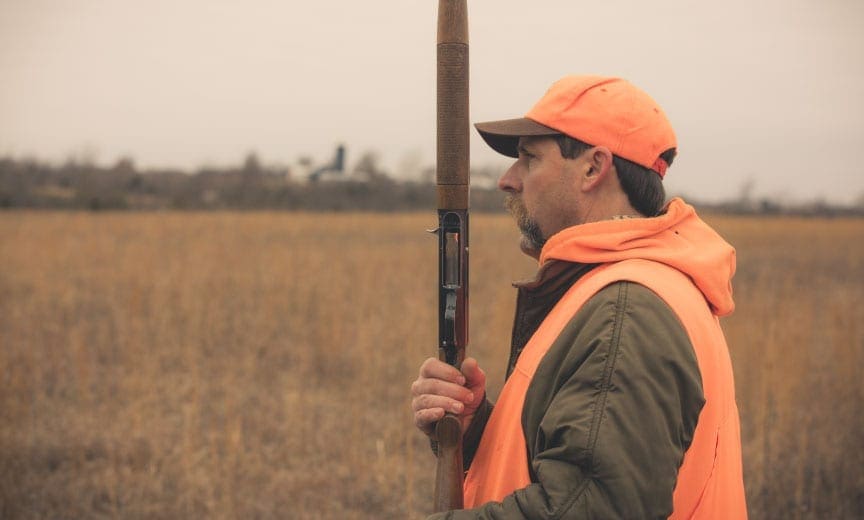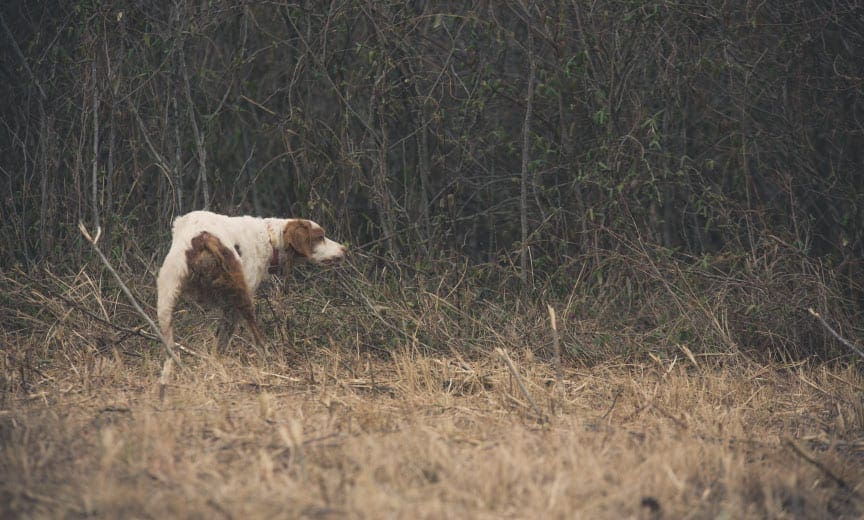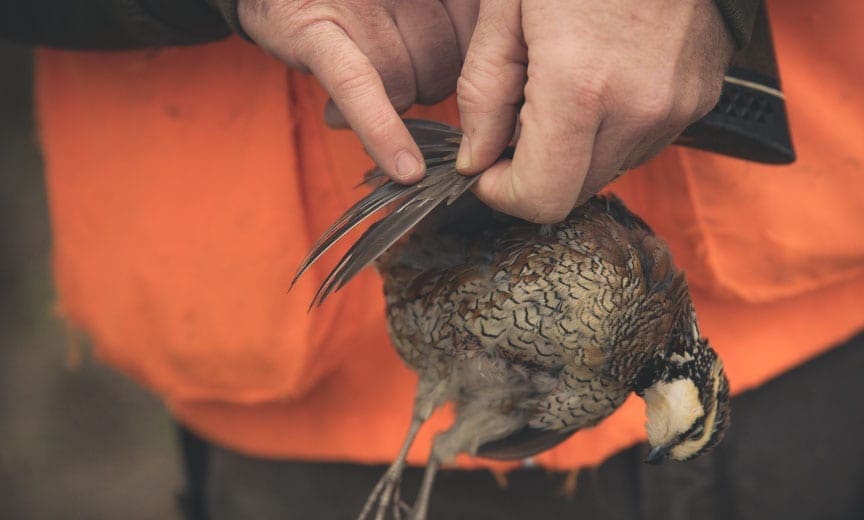Home » Conservation » How Native Prairies Can Help Save Bobwhite Quail
How Native Prairies Can Help Save Bobwhite Quail

Ryan Lisson is a biologist and regular content contributor to…
A recent study in Missouri suggests quail management may have to change to account for native prairie habita
The tall grasses and dried fall flowers make a rasping noise as the dogs work their way along a wild plum thicket. A few individuals clad in blaze orange and shotguns follow closely behind. Suddenly, the dogs go on point and a bobwhite quail erupts from the tangled field edge. That’s how the Project Upland film, Fighting Back, tells its story. But as they mention in the film, that story could be threatened if current trends continue the way they are in Missouri. In fact, another generation might not have that opportunity at all.
Now I freely admit – I love discussions about habitat and the complex role of wildlife managers. Any self-respecting biologist would, right? So for me, the film spurred some very interesting conversations about quail management and the future of this amazing little game bird. To learn more, I reached out to the biologists in the film, Kyle Hedges and Frank Loncarich, to discuss a few follow-up topics on the study they’ve been involved with for the past few years. I then spoke with Adam Keith (who was also in the film) about his quail and habitat observations in Missouri and elsewhere. Whether you’re a biologist, quail hunter, conservationist, or all three, you owe it to yourself to learn more about this subject.
Bobwhite Quail issues
First, it’s a sad reality that the bobwhite quail population has been in a steady decline across the nation for years. One or two generations ago they were plentiful, as was the number of quail hunters who pursued them. But according to the North American Breeding Bird Survey, the bobwhite population has dropped more than 85 percent since 1966. With thousands of trained individuals collecting these data, it’s hard to disagree with the trend. One of the largest suspected reasons for this sharp decline is loss of habitat. Think about it: how much have we changed our landscape since the 1960s? Pretty significantly. It was time for me to call the researchers to get a better idea of their perspectives.
Kyle and Frank are both wildlife biologists for the Missouri Department of Conservation (MDC). In that role, they manage various public lands for different goals, quail conservation being one of them. They were starting to notice some interesting trends between different Conservation Areas, depending on how they were managed. One management practice in the study was called the Intensive Management Model (i.e., “traditional” management) where state resource managers have planted linear food plots and strips of grasses or woody cover. Theoretically, it should offer everything a bobwhite quail needs to survive. The other practice is called the Extensive Management Model (i.e., “grassland” management). In these areas, open grassland habitats with small patches of woody shrubs have been maintained through patch burning and grazing practices to encourage native grasses and forbs.
I asked the MDC biologists what kinds of trends they were noticing between these two types of management practices. They explained that quail observations and hunter harvests were consistently lower on the traditional sites than they were on the natural grassland sites. In biological parlance, the traditional sites were a quail “sink” (i.e., less production, more predation) and the grassland sites were a quail “source” (i.e., more production, less predation).

On the surface, that just seems crazy. In the 1980s, wildlife managers adopted the traditional management practice because of the observed benefits for quail. So how could an area with diverse cover types and food plots not be helping bobwhites survive? That’s exactly what the researchers wanted to answer.
What they studied
Conversation came very naturally for this group of biologists, as Frank and Kyle explained the details of the study. From 2014 to 2018 (plus a few additional pilot studies years before that), the researchers and technicians captured and installed GPS radio collars on more than 1,500 birds (to track their daily movements) and monitored more than 500 nests. To their knowledge, that makes it the largest of any such quail research study in Missouri’s history. In order to focus on the breeding bird recruitment, the study was set up to measure responses to management areas in terms of nesting success and survival rates.
On the traditional management areas, they continued their usual practices of planting food plots between the existing strips of woody cover and grasses. But on the grassland management areas, they used a patch burning and grazing approach. Basically, they burned about one third of a management area per year to provide different structure for nesting birds. Then they allowed cows to moderately graze the entire property from May until August – “moderate” meaning about 1,000 pounds of cattle per 5 acres. Prescribed burns and grazing both remove excess build-up of grass cover and recycle the nutrients (through burning or manure). The recently burned areas and livestock/manure also attract insects, which are critical nutrition for bobwhite chicks.
Missouri grasslands, for the win
Although the exact results varied year-to-year during the study, the grassland areas consistently showed higher nest success rates and adult/juvenile survival rates than traditional areas. In fact, Frank explained that many of the traditional areas performed so poorly that the quail could disappear from these areas in 20 years if nothing else was done. Most biologists consider an average nest success/survival rate of ground-nesting birds to be about 35 percent. On the traditional sites, the nesting success was anywhere from 18 to 33 percent over the five-year study period – not meeting the average. In the grassland areas, the nesting success averaged 43 to 44 percent, which is much better than the average. They also observed that quail in grassland areas nested earlier and produced higher clutch sizes than in the traditionally managed areas.

But the radio tracking revealed a caveat to the grassland success. After tracking the birds’ daily movements throughout the study, disturbance was the single biggest factor that determined where the quail would be. Ultimately, if an area had not been disturbed in some fashion within the last year (even in the grassland areas), quail would avoid it. Kyle used a CRP field as an example. He explained that with heavy rainfall each year, these fields can get so thick within a single season that adult quail and chicks simply cannot move through them. In fact, there was less than 5 percent brood use in undisturbed habitats like these during the study. The beauty of most native warm season grasses is that they are clump-forming, which allows small chicks to easily navigate between them. But when they aren’t disturbed, they get tangled and thick like fescue, forming an impenetrable jungle for the birds. By allowing cattle to follow prescribed burns on the grassland sites, the entire property is disturbed in some fashion each year, thus opening it up for quail use.
In retrospect, these findings make a lot of sense. Adam agreed and explained it this way: the bobwhite quail in Missouri and the prairie states evolved to live in grasslands that were frequently disturbed by wildfires (due to lighting from thunderstorms). This was followed by trampling and grazing from herds of bison. Obviously, we can’t let wildfires run their course these days and bison aren’t really an option in most places. But prescribed burns and cattle can do a pretty fair job of replicating those historic conditions.
Lessons learned
So what were some of the key takeaways from this five year study? First, I was surprised that the traditionally managed areas with food plots performed so poorly. You hear a lot about how important food plots are – even for upland game birds – but that didn’t necessarily hold true for this study. Frank and Kyle acknowledged that while quail did use the food plots during the study, they aren’t necessarily important in Missouri. You see, bobwhites evolved in the state without food plots and can function just fine without them. Kyle likened it to fast food – you still eat it out of convenience, but it’s not necessarily better for you than a proper meal. Likewise, if a quail can quickly eat a lot of food in a short amount of time (i.e., food plots), they’ll seize the opportunity. But given the higher survival rate in the grassland areas, it’s clear they don’t need food plots to thrive.

Importantly, this doesn’t apply in northern states (like the Dakotas, Minnesota, Wisconsin, etc.) where food plots can definitely make a difference. Kyle explained that bobwhites likely expanded their range northward over the last few decades because of the availability of food plots and agricultural crops. With harsh winters and deep snow, quail are much more dependent on winter food sources in these areas. Additionally, southeast states (like Georgia, Tennessee, Alabama, etc.) support quail with open woodlands, thinned pine plantations, and young forests adjacent to farm fields and grasslands. Quail have adapted to survive in different regions. Nevertheless, it’s interesting to note that some of the best states to hunt bobwhites these days include Kansas, Oklahoma, and Nebraska – all states that are dominated by open grassland habitats.
As I chatted with Frank and Kyle, it became clear that this shift in quail management could be a game changer for the MDC and private landowners as well. Instead of spending a lot of time, money, and resources planting quail food plots each year, they could restore native prairie grass species instead. In fact, they may actually earn money by leasing grazing rights on public land during certain times of the year. Certainly as a private landowner, you could raise healthier cattle yourself by letting them graze native grasslands, or you could lease your land. All the while, you would be helping the quail population. It’s a major win-win situation.
The ultimate goal is that this study will inform future quail management efforts throughout Missouri and other prairie-dominated states. Given the long-term population decline on traditionally managed areas, Frank and Kyle are hopeful that these recommendations can be used by other resource managers on public lands, as well as on private lands. Adam echoed those sentiments, being a wildlife consultant himself. “Prescribed fire rotational grazing are some of the best ways to manage your land no matter what species you’re hoping to help!”
Prairie wildlife species and grassland habitats evolved together over thousands and thousands of years. As the saying goes, if it ain’t broke, don’t fix it! I’m optimistic that we’ll continue to adapt our own thinking, based on great science like this, to continue our conservation efforts. Only then will the story mentioned above continue to play out for future generations.
*This article originally appeared in the Fall 2019 Issue of Project Upland Magazine.
Ryan Lisson is a biologist and regular content contributor to several outdoor manufacturers, hunting shows, publications, and blogs. He is an avid small game, turkey, and whitetail hunter from northern Minnesota and loves managing habitat almost as much as hunting. Ryan is also passionate about helping other adults experience the outdoors for their first time, which spurred him to launch Zero to Hunt, a website devoted to mentoring new hunters.




As a new bird dog enthusiast and upland hunter, I find the mystery of what has caused the bird population decline (not just upland species) maddening. Maddening ostly because decades in we haven’t identified a major culprit. Many would say that’s because the problem is highly complex, that it must be some sort of perfect storm. That may be, but our inability to put the finger on the correct largest factors has cost us decades in addressing the problem. Widening the lens a bit, there seem to be to be at least one major identifiable potential culprit that is enormous and may be escaping notice and for me the hunt is in the article: the two habitats’ different impact on insects. With the cataclysmic drop in numbers of insects over the same period of time as the upland bird decline and the huge drop in the numbers of birds of the species that depend on insects for some portion of their lifecycle (upland species, song birds, etc.), it seems at least possible that big agriculture’s pesticides, GMO insect resistant crops and its massive and successful war on insects may be to blame and it’s the only factor ubiquitous enough (and obvious enough?) to have such a nationwide and world-wide impact. Waterfowl and woodcock, species that seem less dependent on insects for food, don’t seem to have suffered nearly the same declines as upland birds. If we don’t address the insect apocalypse wrought by big agriculture / Monsanto, it may be that we can plant all the food plots we want and cure all the eye worm infections we want and still be left a couple of more decades from now with almost no upland birds.